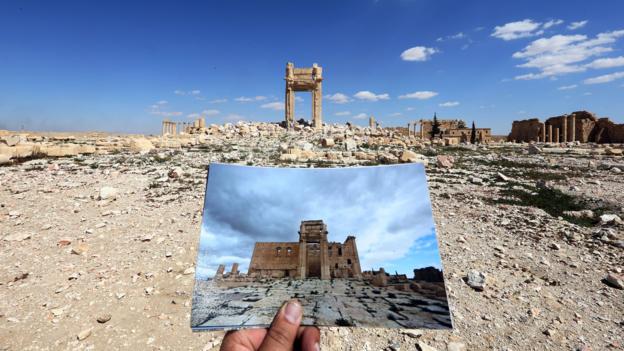
The Syrian army, backed by Russian air strikes, forced the Islamic State from the city of Palmyra at the end of March, ending the 10-month siege of one of Syria’s – and mankind’s – most significant archaeological sites. Now, after a brutal occupation that cost nearly 300 lives, the world is taking stock of what remains.
One of the first to return was Joseph Eid, a Lebanese photographer with Agence France-Presse, who’d visited the Unesco World Heritage Site in 2014 and left with a feeling of dread. “When I arrived two years ago, I did my best to document the tiniest things; there was an idea haunting me that maybe the world wouldn’t be able to see these amazing vestiges again.” Within a year, his fears for Palmyra were realized. “The pictures I had were like a treasure for me, as they were almost the last pictures of Palmyra as the world knew it.”
Eid said watching the news about Palmyra during the occupation was “a misery”. So as soon as the Syrian army began closing in, he applied for a visa and rushed to print the photos he’d taken in 2014. He arrived in Palmyra on 31 March and, with the two-year-old photos in hand, began taking new photos, with “the focus of showing the city before and after IS”. His idea was to superimpose the old photos against what remained. Considering that Palmyra used to be one of the most world’s most intact ancient ruins, the juxtaposition is wrenching.
In one new image, Eid holds a 2014 photo in the foreground of the 2,000-year-old Temple of Baalshamin; standing in the same place two years later, there’s nothing left but rubble. In another, he places his original photo of the Temple of Bel in front of the same site – all that’s left is two door jambs and a lintel. In others, the Arc du Triomphe no longer has its arch, and the stone-carved portraits that once were hung on the museum’s walls have been removed.
Despite the destruction, some are cautiously optimistic that Palmyra’s treasures can be restored. For now, most countries – including the UK, US, and Australia – advise against all travel to Syria because of the ongoing violence. But the hope is that someday, visitors will return to witness the wonder of Palmyra. Syria’s director of antiquities estimates that around 80% of the site remains intact, including the Roman amphitheatre, the colonnaded Decumanus Maximus road and the hillside citadel. Experts say that with the help of state-of-the art technology, much of Palmyra can be reconstructed.
Yet Eid thinks Syria should carefully consider how much – or little – should be refurbished. “On one side, partially restoring them will give an idea of what these remains once looked like. But on the other side, their scars should be a witness to what happened to the city in that certain moment of history.”
If you liked this story, sign up for the weekly bbc.com features newsletter, called “If You Only Read 6 Things This Week”. A handpicked selection of stories from BBC Future, Earth, Culture, Capital, Travel and Autos, delivered to your inbox every Friday.










